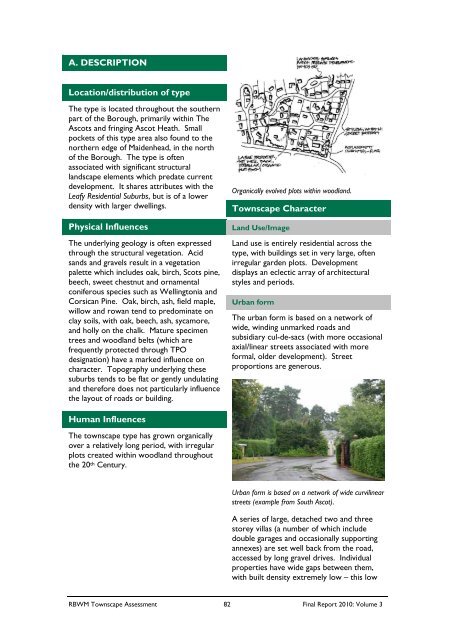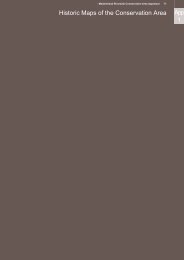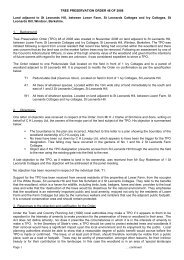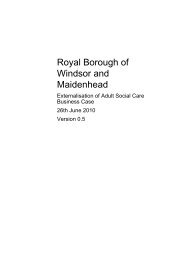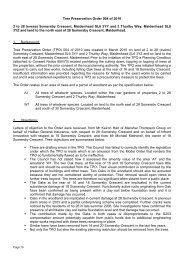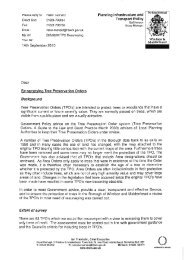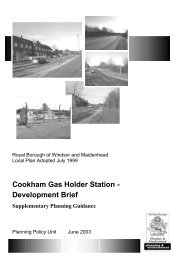5: victorian villages - The Royal Borough of Windsor and Maidenhead
5: victorian villages - The Royal Borough of Windsor and Maidenhead
5: victorian villages - The Royal Borough of Windsor and Maidenhead
Create successful ePaper yourself
Turn your PDF publications into a flip-book with our unique Google optimized e-Paper software.
A. DESCRIPTION<br />
Location/distribution <strong>of</strong> type<br />
<strong>The</strong> type is located throughout the southern<br />
part <strong>of</strong> the <strong>Borough</strong>, primarily within <strong>The</strong><br />
Ascots <strong>and</strong> fringing Ascot Heath. Small<br />
pockets <strong>of</strong> this type area also found to the<br />
northern edge <strong>of</strong> <strong>Maidenhead</strong>, in the north<br />
<strong>of</strong> the <strong>Borough</strong>. <strong>The</strong> type is <strong>of</strong>ten<br />
associated with significant structural<br />
l<strong>and</strong>scape elements which predate current<br />
development. It shares attributes with the<br />
Leafy Residential Suburbs, but is <strong>of</strong> a lower<br />
density with larger dwellings.<br />
Physical Influences<br />
<strong>The</strong> underlying geology is <strong>of</strong>ten expressed<br />
through the structural vegetation. Acid<br />
s<strong>and</strong>s <strong>and</strong> gravels result in a vegetation<br />
palette which includes oak, birch, Scots pine,<br />
beech, sweet chestnut <strong>and</strong> ornamental<br />
coniferous species such as Wellingtonia <strong>and</strong><br />
Corsican Pine. Oak, birch, ash, field maple,<br />
willow <strong>and</strong> rowan tend to predominate on<br />
clay soils, with oak, beech, ash, sycamore,<br />
<strong>and</strong> holly on the chalk. Mature specimen<br />
trees <strong>and</strong> woodl<strong>and</strong> belts (which are<br />
frequently protected through TPO<br />
designation) have a marked influence on<br />
character. Topography underlying these<br />
suburbs tends to be flat or gently undulating<br />
<strong>and</strong> therefore does not particularly influence<br />
the layout <strong>of</strong> roads or building.<br />
Organically evolved plots within woodl<strong>and</strong>.<br />
Townscape Character<br />
L<strong>and</strong> Use/Image<br />
L<strong>and</strong> use is entirely residential across the<br />
type, with buildings set in very large, <strong>of</strong>ten<br />
irregular garden plots. Development<br />
displays an eclectic array <strong>of</strong> architectural<br />
styles <strong>and</strong> periods.<br />
Urban form<br />
<strong>The</strong> urban form is based on a network <strong>of</strong><br />
wide, winding unmarked roads <strong>and</strong><br />
subsidiary cul-de-sacs (with more occasional<br />
axial/linear streets associated with more<br />
formal, older development). Street<br />
proportions are generous.<br />
Human Influences<br />
<strong>The</strong> townscape type has grown organically<br />
over a relatively long period, with irregular<br />
plots created within woodl<strong>and</strong> throughout<br />
the 20 th Century.<br />
Urban form is based on a network <strong>of</strong> wide curvilinear<br />
streets (example from South Ascot).<br />
A series <strong>of</strong> large, detached two <strong>and</strong> three<br />
storey villas (a number <strong>of</strong> which include<br />
double garages <strong>and</strong> occasionally supporting<br />
annexes) are set well back from the road,<br />
accessed by long gravel drives. Individual<br />
properties have wide gaps between them,<br />
with built density extremely low – this low<br />
RBWM Townscape Assessment 82 Final Report 2010: Volume 3


